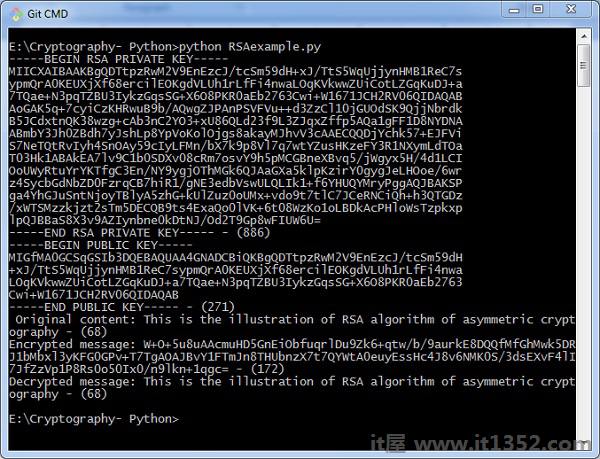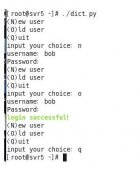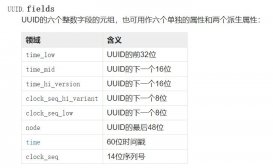RSA算法
RSA算法是一种公钥加密技术,被认为是最安全的加密方式.它是由Rivest,Shamir和Adleman于1978年发明的,因此命名为 RSA 算法.
RSA算法具有以下特征 :
- RSA算法是包含素数的整数在有限域中的一种流行取幂./p>
- 此方法使用的整数足够大,难以解决.
- 此算法中有两组密钥:私钥和公钥.
您必须完成以下步骤才能工作关于RSA算法 :
步骤1:生成RSA模数
初始过程从选择两个素数即p和q开始,然后计算他们的产品N,如图所示去;
N = p * q
这里,设N为指定的大数.
步骤2:派生数(e)
将数字e视为派生数,该数字应大于1且小于(p-1)和(q-1).主要条件是应该没有(p-1)和(q-1)的公因子,除了1
步骤3:公钥
指定的一对数字 n 和 e 形成RSA公钥并将其公开.
步骤4:私钥
私钥 d 是根据数字p,q和e计算的.数字之间的数学关系如下:
ed = 1 mod(p-1)(q-1)
上面的公式是扩展欧几里得算法的基本公式,它以p和q作为输入参数.
加密公式
考虑将明文消息发送给公钥为(n,e)的人的发件人.要在给定方案中加密纯文本消息,请使用以下语法 :
C = Pe mod n
解密公式
解密过程非常简单,包括用于系统方法计算的分析.考虑到接收器 C 具有私钥 d ,结果模数将计算为 :
Plaintext = Cd mod n
生成RSA密钥
我们将重点介绍使用Python逐步实现RSA算法.
涉及以下步骤生成RSA密钥 :
- 创建两个大的素数,即 p 和 q 的.这些数字的乘积称为 n ,其中 n = p * q
- 生成一个(p-1)和(q-1)相对素数的随机数.将数字称为 e .
- 计算e的模数逆.计算出的倒数将被称为 d .
生成RSA密钥的算法
我们需要两个主要算法来使用Python和minus生成RSA密钥; Cryptomath模块和 Rabin Miller模块.
Cryptomath模块
cryptomath的源代码遵循RSA算法的所有基本实现的模块如下
|
1
2
3
4
5
6
7
8
9
10
11
12
13
14
|
def gcd(a, b): while a != 0: a, b = b % a, a return bdef findModInverse(a, m): if gcd(a, m) != 1: return None u1, u2, u3 = 1, 0, a v1, v2, v3 = 0, 1, m while v3 != 0: q = u3 // v3 v1, v2, v3, u1, u2, u3 = (u1 - q * v1), (u2 - q * v2), (u3 - q * v3), v1, v2, v3 return u1 % m |
RabinMiller模块
源代码遵循RSA算法的所有基本实现的RabinMiller模块如下<
|
1
2
3
4
5
6
7
8
9
10
11
12
13
14
15
16
17
18
19
20
21
22
23
24
25
26
27
28
29
30
31
32
33
34
35
36
37
38
39
40
41
42
43
44
|
import randomdef rabinMiller(num): s = num - 1 t = 0 while s % 2 == 0: s = s // 2 t += 1 for trials in range(5): a = random.randrange(2, num - 1) v = pow(a, s, num) if v != 1: i = 0 while v != (num - 1): if i == t - 1: return False else: i = i + 1 v = (v ** 2) % num return Truedef isPrime(num): if (num 7< 2): return False lowPrimes = [2, 3, 5, 7, 11, 13, 17, 19, 23, 29, 31, 37, 41, 43, 47, 53, 59, 61, 67, 71, 73, 79, 83, 89, 97, 101, 103, 107, 109, 113, 127, 131, 137, 139, 149, 151, 157, 163, 167, 173, 179, 181, 191, 193, 197, 199, 211, 223, 227, 229, 233, 239, 241, 251, 257, 263, 269, 271, 277, 281, 283, 293, 307, 311, 313,317, 331, 337, 347, 349, 353, 359, 367, 373, 379, 383, 389, 397, 401, 409, 419, 421, 431, 433, 439, 443, 449, 457, 461, 463, 467, 479, 487, 491, 499, 503, 509, 521, 523, 541, 547, 557, 563, 569, 571, 577, 587, 593, 599, 601, 607, 613, 617, 619, 631, 641, 643, 647, 653, 659, 661, 673, 677, 683, 691, 701, 709, 719, 727, 733, 739, 743, 751, 757, 761, 769, 773, 787, 797, 809, 811, 821, 823, 827, 829, 839, 853, 857, 859, 863, 877, 881, 883, 887, 907, 911, 919, 929, 937, 941, 947, 953, 967, 971, 977, 983, 991, 997] if num in lowPrimes: return True for prime in lowPrimes: if (num % prime == 0): return False return rabinMiller(num)def generateLargePrime(keysize = 1024): while True: num = random.randrange(2**(keysize-1), 2**(keysize)) if isPrime(num): return num |
生成RSA密钥完整代码
|
1
2
3
4
5
6
7
8
9
10
11
12
13
14
15
16
17
18
19
20
21
22
23
24
25
26
27
28
29
30
31
32
33
34
35
36
37
38
39
40
41
42
43
44
45
46
47
48
49
50
|
import random, sys, os, rabinMiller, cryptomathdef main(): makeKeyFiles('RSA_demo', 1024)def generateKey(keySize): # Step 1: Create two prime numbers, p and q. Calculate n = p * q. print('Generating p prime...') p = rabinMiller.generateLargePrime(keySize) print('Generating q prime...') q = rabinMiller.generateLargePrime(keySize) n = p * q # Step 2: Create a number e that is relatively prime to (p-1)*(q-1). print('Generating e that is relatively prime to (p-1)*(q-1)...') while True: e = random.randrange(2 ** (keySize - 1), 2 ** (keySize)) if cryptomath.gcd(e, (p - 1) * (q - 1)) == 1: break # Step 3: Calculate d, the mod inverse of e. print('Calculating d that is mod inverse of e...') d = cryptomath.findModInverse(e, (p - 1) * (q - 1)) publicKey = (n, e) privateKey = (n, d) print('Public key:', publicKey) print('Private key:', privateKey) return (publicKey, privateKey)def makeKeyFiles(name, keySize): # Creates two files 'x_pubkey.txt' and 'x_privkey.txt' (where x is the value in name) with the the n,e and d,e integers written in them, # delimited by a comma. if os.path.exists('%s_pubkey.txt' % (name)) or os.path.exists('%s_privkey.txt' % (name)): sys.exit('WARNING: The file %s_pubkey.txt or %s_privkey.txt already exists! Use a different name or delete these files and re-run this program.' % (name, name)) publicKey, privateKey = generateKey(keySize) print() print('The public key is a %s and a %s digit number.' % (len(str(publicKey[0])), len(str(publicKey[1])))) print('Writing public key to file %s_pubkey.txt...' % (name)) fo = open('%s_pubkey.txt' % (name), 'w')fo.write('%s,%s,%s' % (keySize, publicKey[0], publicKey[1])) fo.close() print() print('The private key is a %s and a %s digit number.' % (len(str(publicKey[0])), len(str(publicKey[1])))) print('Writing private key to file %s_privkey.txt...' % (name)) fo = open('%s_privkey.txt' % (name), 'w') fo.write('%s,%s,%s' % (keySize, privateKey[0], privateKey[1])) fo.close()# If makeRsaKeys.py is run (instead of imported as a module) call# the main() function.if __name__ == '__main__': main() |
输出
生成公钥和私钥并将其保存在相应的文件中,如以下输出所示.

以上就是python密码学RSA算法及秘钥创建教程的详细内容,更多关于python密码学RSA算法秘钥的资料请关注服务器之家其它相关文章!
原文链接:https://www.it1352.com/OnLineTutorial/cryptography_with_python/cryptography_with_python_understanding_rsa_algorithm.html










